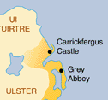![]() The
Anglo-Norman Invasion of Ireland
The
Anglo-Norman Invasion of Ireland
![Carrickfergus Castle (County Antrim, Northern Ireland), Norman keep in the centre [Northern Ireland Tourist Board]](images/carrick.jpg) Henry
II had considered the conquest of Ireland since the beginning of his reign,
but after the murder of Thomas Becket he saw it as an opportunity to please
the pope who regarded the Irish church as having customs at odds with Roman
practice. In addition, Anglo-Norman adventurers from Wales were already
involved in Irish affairs.
Henry
II had considered the conquest of Ireland since the beginning of his reign,
but after the murder of Thomas Becket he saw it as an opportunity to please
the pope who regarded the Irish church as having customs at odds with Roman
practice. In addition, Anglo-Norman adventurers from Wales were already
involved in Irish affairs.
 Ireland itself was a ruled by
regional kings who competed for the honour of becoming High King. Warfare
between the kingdoms appears to have been a regular occurrence. Those who
sought to reform the Irish church on Roman lines and the monks in the new
Cistercian monasteries felt insecure and looked to Henry for assistance.
Ireland itself was a ruled by
regional kings who competed for the honour of becoming High King. Warfare
between the kingdoms appears to have been a regular occurrence. Those who
sought to reform the Irish church on Roman lines and the monks in the new
Cistercian monasteries felt insecure and looked to Henry for assistance.
![Grey Abbey [County Down, Northern Ireland]. (Northern Ireland Tourist Board)](images/grey.jpg) In 1170 Dermot McMurrough, King of
Leinster and claimant to the High Kingship, sought aid from Henry who allowed
him to recruit soldiers in Wales. They included the Earl of Pembroke, known as
‘Strongbow’. A combined Anglo-Norman and Irish army captured Dublin in
September 1170 and held out for a year against native forces. In October 1171
Henry himself came to Ireland and received submission from all parties.
In 1170 Dermot McMurrough, King of
Leinster and claimant to the High Kingship, sought aid from Henry who allowed
him to recruit soldiers in Wales. They included the Earl of Pembroke, known as
‘Strongbow’. A combined Anglo-Norman and Irish army captured Dublin in
September 1170 and held out for a year against native forces. In October 1171
Henry himself came to Ireland and received submission from all parties.
Anglo-Norman colonisation of Ireland continued and the pace quickened with the campaign of John de Courcy in Ulster after 1177. In 1185 Henry’s youngest son John, designated King of Ireland, was sent to his new domain, but soon departed as the death of his brother Geoffrey led King Henry to give new responsibilities to his sons.